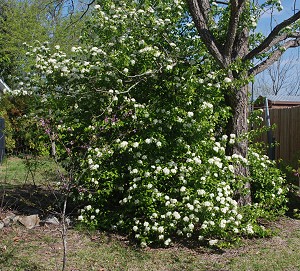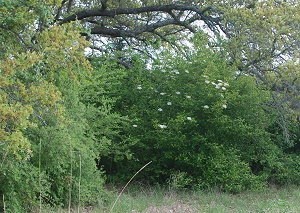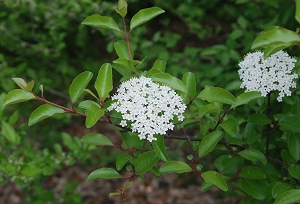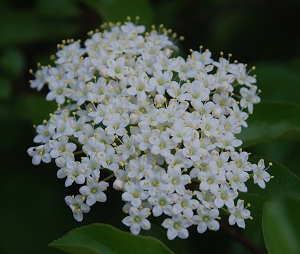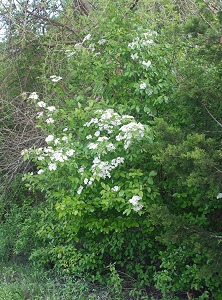Along the fencerows and in the creek bottoms at this time of year, you’ll see sudden puffs of white on shrubs that range from waist high up to about 15 feet. The first white-flowering shrubs–with discrete “powderpuff” flowers–are Rusty Blackhaw Viburnum, Viburnum rufidulum, a native here which is being destroyed by development. That’s because developers and land managers think of anything but large oaks as “brush” to be cleared away.
This specimen is from a commercial native-plants source, and from material collected east of here–it blooms about two weeks ahead of the locals. But it’s the same species, and as you can see a gorgeous woody shrub. We have one on either side of the driveway near the property line–this one, which gets more sun in winter, is the larger.
On its own, it forms part of the riparian woodland complexes around here, and also grows along fencerows (making it a target for destruction during refencing, widening of roads, etc.) Some beautiful large ones presently blooming along US183 north of Highway 29 are in the path of construction. it grows alongside and intermingled with Roughleaf Dogwood, Possumhaw, Mexican plum and thicketing plums, Redbud, and Ashe Juniper.
This one is part of the understory beneath an old live oak growing along a drainage channel…near it are Cherry Laurel, Possumhaw, Elbowbush, and young live oaks, as well as the live oak that partially shades it. A close up of the flowering clusters shows the beauty of the shiny green leaves and red stems:
Each delicate, clean-white flower in the cluster has five petals and golden stamens that stick up above the petals:
But in addition to their beauty in spring–beauty that can be seen from a speeding car, or enjoyed in detail up close–Rusty Blackhaw Viburnum has other value as a landscape plant and in the local ecology. It produces sweet berries with a blue “bloom” that are valuable wildlife food, especially for migrating songbirds. (You can taste one yourself–they’re not toxic. ) It’s drought tolerant (none of the viburnums on the 80 acres had supplemental water during the recent drought) but can also handle sustained rains and flooding. In the fall, the foliage turns shades of red–while still maintaining its shiny surface–and holds that foliage late.
In the creek woods, we have most of our local-natives–both on the margins of the creek woods, like this one, sandwiched between an osage orange and an Ashe juniper, and deeper in:
This plant has grown since we got the Japanese honeysuckle off it, and some invasive privet away from it. Other creek woods viburnums are harder to photograph because of the growth around them, but they’re still a delight. The young ones are doing better now, since they aren’t trampled by cattle or strangled by vines. They’re slow growing, and must reach a certain size before flowering, but they’re pretty all year anyway.
In a week or so, the Roughleaf Dogwood will flower with similar (from a distance) puffballs of white, but the Rusty Blackhaw Viburnum is my favorite. The dogwoods grow faster, and we have lots of them, but the real reason for my relative dislike (only relative) is that the Roughleaf Dogwoods stink for several weeks in the summer.
As with other valuable natives that grow on undeveloped land, it’s a shame that these beauties are destroyed to create sterile plots for homes, pavement for shopping centers, and roads….that developers don’t try to identify and save the best of the natives. They’re easy to identify in any season by the pattern of leaves (pairs of the shiny leaves come off the stems opposite to each other), the striking bud shapes in winter, the red color in the fall and early winter, and the flowers and berries in spring and summer.
If you find one or more on your place, be sure to keep track of them and watch for seedlings. If you don’t, and want one, go to one of the native plants nurseries that carries them–they can be propagated with cuttings there. They’re increasingly uncommon in the wild, due to development pressure but also to plant thieves, so if you do buy a nursery specimen, be sure that nursery propagates them (by seed or by cuttings) and isn’t selling you a stolen one.
